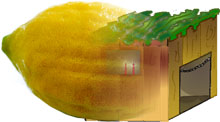Gedalia’s appointment and the prospective return of the Jewish population were opposed by the ruler of Ammon (modern Amman, Jordan), whose agents assassinated Gedaliah. The Fast is kept as a day of mourning, since Gedaliah’s death was followed by the killing and final exile of many thousands.
The Fast of Tammuz
The 17th Tammuz is considered an historic day of calamity. It is a tradition that the following events occurred on this date:
Moses descended Mount Sinai and upon seeing the Jews worshipping the Golden Calf, proceeded to break the first set of Tablets carrying the Ten Commandments.
The priests in the First Temple stopped offering the daily sacrifice on this day.
The walls of Jerusalem were breached in the year 3184 (586 BCE) after many months of siege by Nebuchadnezzar and his Babylonian forces.
In the time of the Roman persecution, Apostomos, leader of the enemy forces, publicly burned the Torah.
Titus, King of Rome, breached the walls of Jerusalem in 3760 (70 CE).
Pope Gregory IX ordered the confiscation of all manuscripts of the Talmud in 4999 (1239).
In 1391, more than 4,000 Jews were killed in Spain.
In 4319 (1559) the Jewish Quarter of Prague was burned and looted.
The Kovno ghetto was liquidated in 5704 (1944).
In 5730 (1970) Libya ordered the confiscation of Jewish property.
The Fast of Esther
This fast is observed in commemoration of the three-day fast observed by Mordechai and Esther and all of the Jews of Shushan, Persia, as described in the Book of Esther. It is the date on which Haman, the Jew’s enemy, had planned to destroy them, but was foiled by Esther’s intervention with he King.
The Fast of the Firstborn
The Fast of the Firstborn reminds us of the last and most horrible plague that was visited upon the Egyptians. After Pharoah had refused to let the Children of Israel go nine times, Moses warned that the next plague would be that every first-born son in the land would die. Moses then told the Israelites how to save their sons from being caught up in the plague.
he instructed them to sacrifice a lamb and put some of its blood on the doorposts of their homes. When the Angel of Death came to Egypt to kill all the first-born sons, the angel would recognise and ‘pass over’ the Jewish homes.
This is where the English name for Pesach, ‘Passover’, comes from. To remember being saved, the first-born son in a Jewish family fasts from dawn on Erev Pesach until the Seder.




 A traditonal Sephardi Torah scroll in silver casing
A traditonal Sephardi Torah scroll in silver casing